Home > Directory Home > Drawing Lessons > Drawing for Beginners >Drawing Lighting and Shading
DRAWING & Sketching Shadows and Lights : How to Draw with Shading and Lighting
|
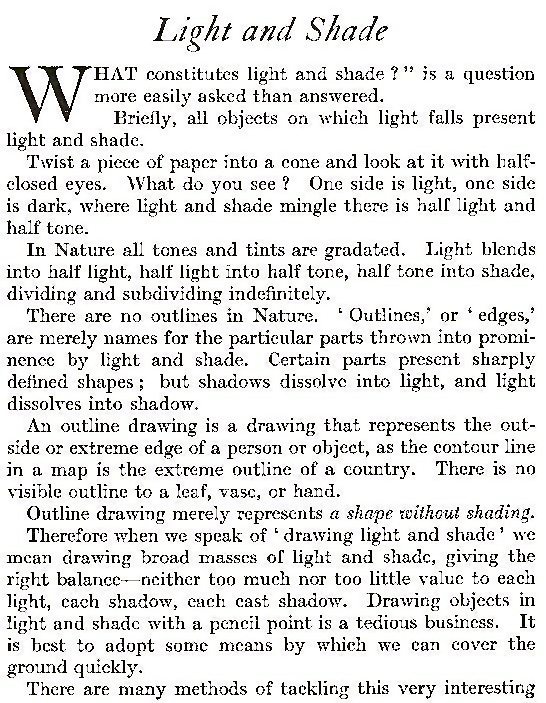
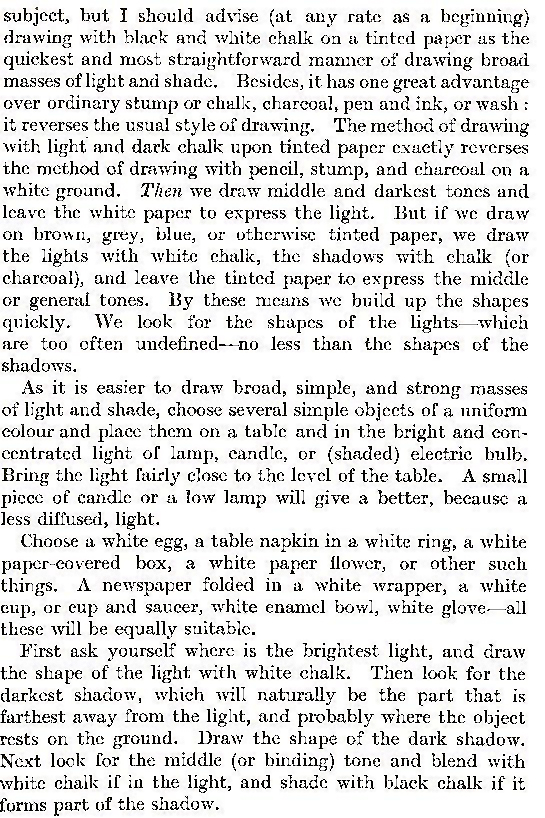
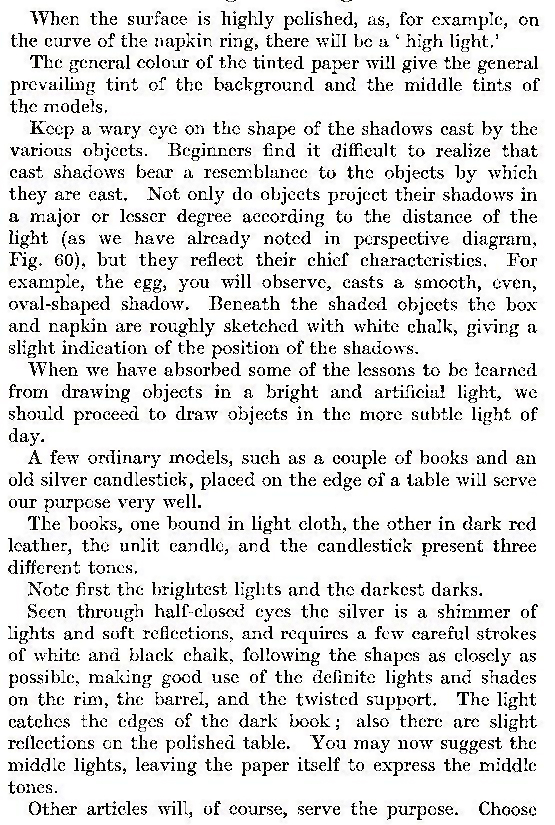
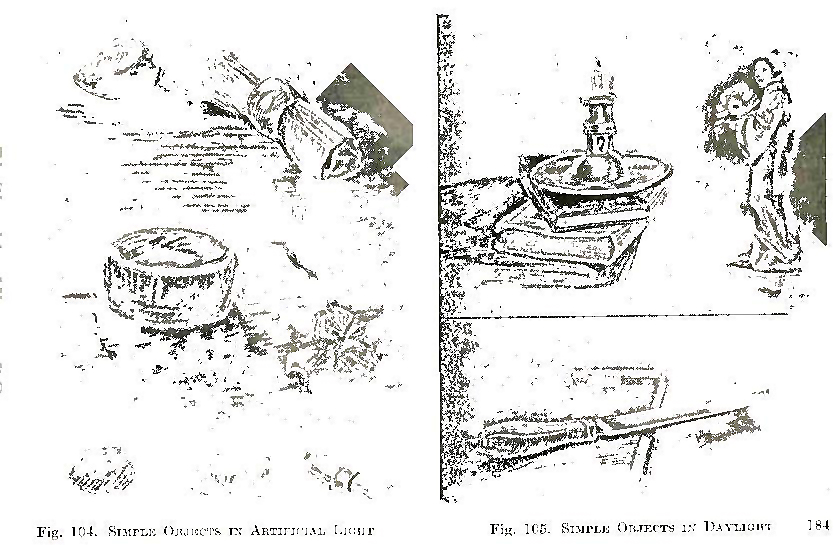
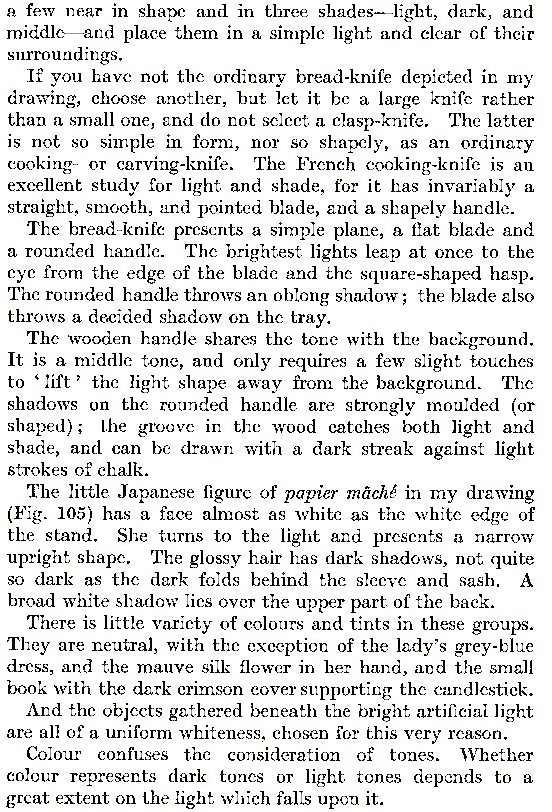
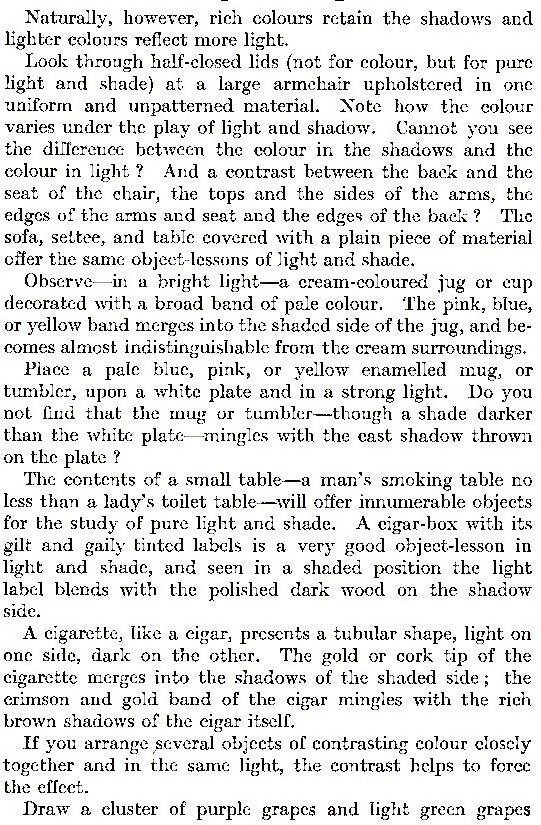

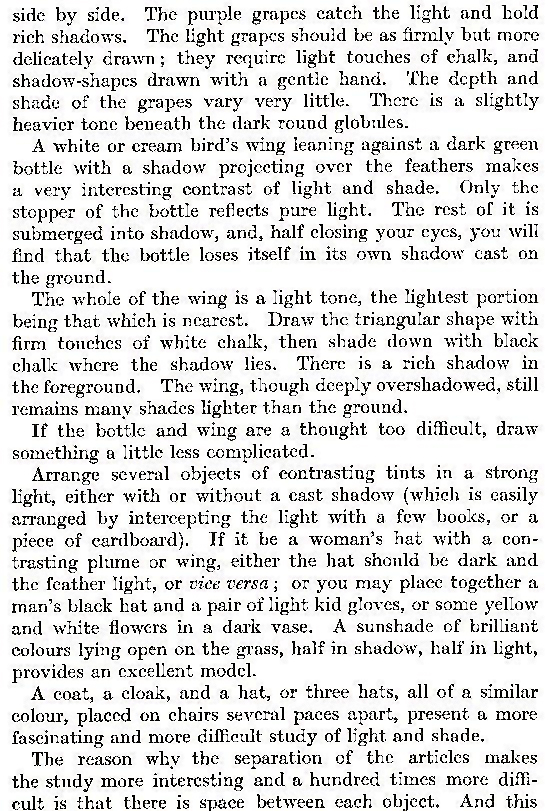
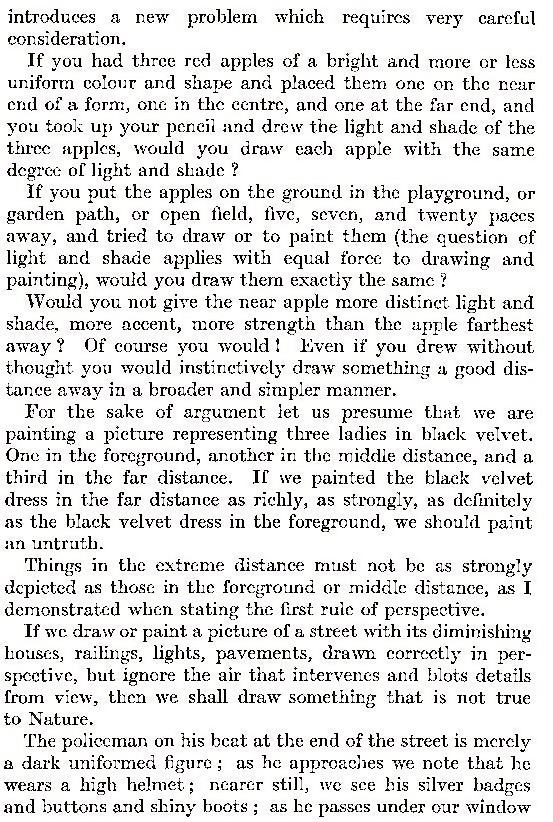
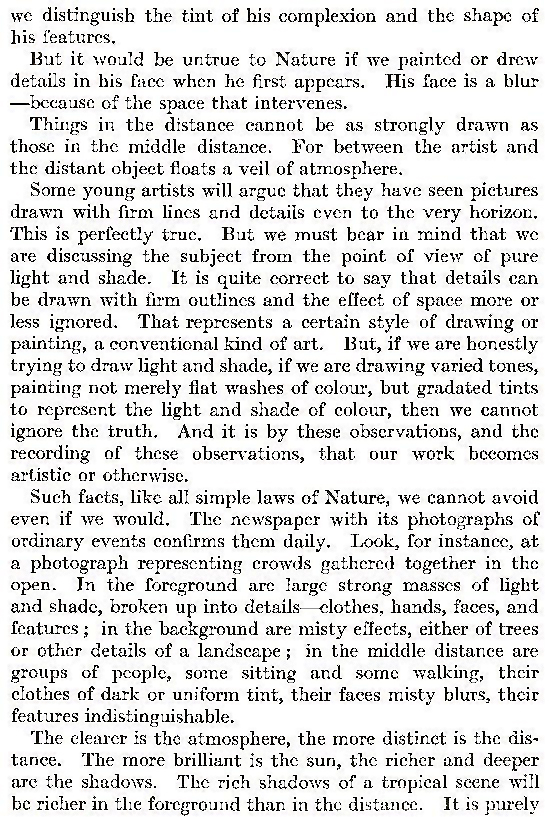
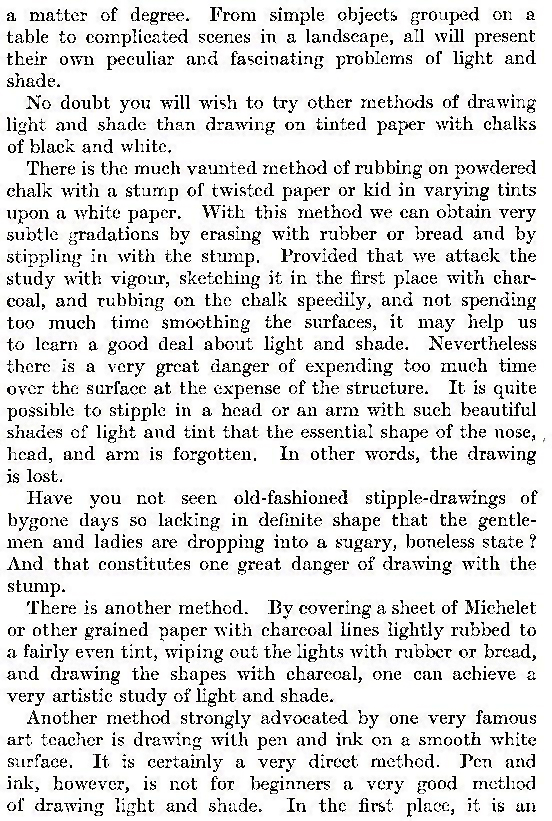



GO BACK TO THE HOME PAGE FOR TUTORIALS FOR BEGINNING ARTISTS
[The above words are pictures of text, below is the actual text if you need to copy a paragraph or two]
LIGHT AND SHADE
What constitutes light and shade? " is a question more easily asked than answered. Briefly, all objects on which light falls present light and shade.
Twist a piece of paper into a cone and look at it with half-closed eyes. What do you see ? One side is light, one side is dark, where light and shade mingle there is half light and half tone.
In Nature all tones and tints are gradated. Light blends into half light, half light into half tone, half tone into shade, dividing and subdividing indefinitely.
There are no outlines in Nature. ' Outlines,' or ' edges,' are merely names for the particular parts thrown into prominence by light and shade. Certain parts present sharply defined shapes ; but shadows dissolve into light, and light dissolves into shadow.
An outline drawing is a drawing that represents the outside or extreme edge of a person or object, as the contour line in a map is the extreme outline of a country. There is no visible outline to a leaf, vase, or hand.
Outline drawing merely represents a shape without shading.
Therefore when we speak of ' drawing light and shade ' we mean drawing broad masses of light and shade, giving the right balance—neither too much nor too little value to each light, each shadow, each cast shadow. Drawing objects in light and shade with a pencil point is a tedious business. It is best to adopt some means by which we can cover the ground quickly.
There are many methods of tackling this very interesting subject, but I should advise (at any rate as a beginning) drawing with black and white chalk on a tinted paper as the quickest and most straightforward manner of drawing broad masses of light and shade. Besides, it has one great advantage over ordinary stump or chalk, charcoal, pen and ink, or wash : it reverses the usual style of drawing. The method of drawing with light and dark chalk upon tinted paper exactly reverses the method of drawing with pencil, stump, and charcoal on a white ground. Then we draw middle and darkest tones and leave the white paper to express the light. But if we draw on brown, grey, blue, or otherwise tinted paper, we draw the lights with white chalk, the shadows with chalk (or charcoal), and le—ave the tinted paper to express the middle or general tones. By these means we build up the shapes quickly. We look for the shapes of the lights—which are too often undefined—no less than the shapes of the shadows.
As it is easier to draw broad, simple, and strong masses of light and shade, choose several simple objects of a uniform colour and place them on a table and in the bright and concentrated light of lamp, candle, or (shaded) electric bulb. Bring the light fairly close to the level of the table. A small piece of candle or a low lamp will give a better, because a less diffused, light.
Choose a white egg, a table napkin in a white ring, a white paper-covered box, a white paper flower, or other such things. A newspaper folded in a white wrapper, a white cup, or cup and saucer, white enamel bowl, white glove—all these will be equally suitable.
First ask yourself where is the brightest light, and draw the shape of the light with white chalk. Then look for the darkest shadow, which will naturally be the part that is farthest away from the light, and probably where the object rests on the ground.
Draw the shape of the dark shadow. Next look for the middle (or binding) tone and blend with white chalk if in the light, and shade with black chalk if it forms part of the shadow.
When the surface is highly polished, as, for example, on the curve of the napkin ring, there will be a high light.'
The general colour of the tinted paper will give the general prevailing tint of the background and the middle tints of the models.
Keep a wary eye on the shape of the shadows cast by the various objects. Beginners find it difficult to realize that cast shadows bear a resemblance to the objects by which they are cast. Not only do objects project their shadows in a major or lesser degree according to the distance of the light (as we have already noted in perspective diagram, Fig. 60), but they reflect their chief characteristics. For example, the egg, you will observe, casts a smooth, even, oval-shaped shadow. Beneath the shaded objects the box and napkin are roughly sketched with white chalk, giving a slight indication of the position of the shadows.
When we have absorbed some of the lessons to be learned from drawing objects in a bright and artificial light, we should proceed to draw objects in the more subtle light of day.
A few ordinary models, such as a couple of books and an old silver candlestick, placed on the edge of a table will serve our purpose very well.
The books, one bound in light cloth, the other in dark red leather, the unlit candle, and the candlestick present three different tones.
Note first the brightest lights and the darkest darks.
Seen through half-closed eyes the silver is a shimmer of lights and soft reflections, and requires a few careful strokes of white and black chalk, following the shapes as closely as possible, making good use of the definite lights and shades on the rim, the barrel, and the twisted support. The light catches the edges of the dark book ; also there are slight reflections on the polished table. You may now suggest the middle lights, leaving the paper itself to express the middle tones.
Other articles will, of course, serve the purpose. Choose a few near in shape and in three shades—light, dark, and middle—and place them in a simple light and clear of their surroundings.
If you have not the ordinary bread-knife depicted in my drawing, choose another, but let it be a large knife rather than a small one, and do not select a clasp-knife. The latter is not so simple in form, nor so shapely, as an ordinary cooking- or carving-knife. The French cooking-knife is an excellent study for light and shade, for it has invariably a straight, smooth, and pointed blade, and a shapely handle.
The bread-knife presents a simple plane, a flat blade and a rounded handle. The brightest lights leap at once to the eye from the edge of the blade and the square-shaped hasp. The rounded handle throws an oblong shadow ; the blade also throws a decided shadow on the tray.
The wooden handle shares the tone with the background. It is a middle tone, and only requires a few slight touches to ' lift' the light shape away from the background. The shadows on the rounded handle are strongly moulded (or shaped) ; the groove in the wood catches both light and shade, and can be drawn with a dark streak against light strokes of chalk.
The little Japanese figure of papier mache in my drawing (Fig. 105) has a face almost as white as the white edge of the stand.
She turns to the light and presents a narrow upright shape. The glossy hair has dark shadows, not quite so dark as the dark folds behind the sleeve and sash. A broad white shadow lies over the upper part of the back.
There is little variety of colours and tints in these groups. They are neutral, with the exception of the lady's grey-blue dress, and the mauve silk flower in her hand, and the small book with the dark crimson cover supporting the candlestick.
And the objects gathered beneath the bright artificial light are all of a uniform whiteness, chosen for this very reason.
Colour confuses the consideration of tones. Whether colour represents dark tones or light tones depends to a great extent on the light which falls upon it.
Naturally, however, rich colours retain the shadows and lighter colours reflect more light.
Look through half-closed lids (not for colour, but for pure light and shade) at a large armchair upholstered in one uniform and unpatterned material. Note how the colour varies under the play of light and shadow. Cannot you see the difference between the colour in the shadows and the colour in light ? And a contrast between the back and the seat of the chair, the tops and the sides of the arms, the edges of the arms and seat and the edges of the back ? The sofa, settee, and table covered with a plain piece of material offer the same object-lessons of light and shade.
Observe—in a bright light—a cream-coloured jug or cup decorated with a broad band of pale colour. The pink, blue, or yellow band merges into the shaded side of the jug, and becomes almost indistinguishable from the cream surroundings.
Place a pale blue, pink, or yellow enamelled mug, or tumbler, upon a white plate and in a strong light. Do you not find that the mug or tumbler—though a shade darker than the white plate—mingles with the cast shadow thrown on the plate?
The contents of a small table—a man's smoking table no less than a lady's toilet table—will offer innumerable objects for the study of pure light and shade. A cigar-box with its gilt and gaily tinted labels is a very good object-lesson in light and shade, and seen in a shaded position the light label blends with the polished dark wood on the shadow side.
A cigarette, like a cigar, presents a tubular shape, light on one side, dark on the other. The gold or cork tip of the cigarette merges into the shadows of the shaded side ; the crimson and gold band of the cigar mingles with the rich brown shadows of the cigar itself.
If you arrange ,several objects of contrasting colour closely together and in the same light, the contrast helps to force the effect.
Draw a cluster of purple grapes and light green grapes side by side. The purple grapes catch the light and hold rich shadows. The light grapes should be as firmly but more delicately drawn ; they require light touches of chalk, and shadow-shapes drawn with a gentle hand. The depth and shade of the grapes vary very little. There is a slightly heavier tone beneath the dark round globules.
A white or cream bird's wing leaning against a dark green battle with a shadow projecting over the feathers makes a very interesting contrast of light and shade. Only the stopper of the bottle reflects pure light. The rest of it is submerged into shadow, and, half closing your eyes, you will find that the bottle loses itself in its own shadow cast on the ground.
The whole of the wing is a light tone, the lightest portion being that which is nearest. Draw the triangular shape with firm touches of white chalk, then shade down with black chalk where the shadow lies. There is a rich shadow in the foreground. The wing, though deeply overshadowed, still remains many shades lighter than the ground.
If the bottle and wing are a thought too difficult, draw something a little less complicated.
Arrange several objects of contrasting tints in a strong light, either with or without a cast shadow (which is easily arranged by intercepting the light with a few books, or a piece of cardboard). If it be a woman's hat with a contrasting plume or wing, either the hat should be dark and the feather light, or vice versa ; or you may place together a man's black hat and a pair of light kid gloves, or some yellow and white flowers in a dark vase. A sunshade of brilliant colours lying open on the grass, half in shadow, half in light, provides an excellent model.
A coat, a cloak, and a hat, or three hats, all of a similar colour, placed on chairs several paces apart, present a more fascinating and more difficult study of light and shade.
The reason why the separation of the articles makes the study more interesting and a hundred times more difficult is that there is space between each object. And this introduces a new problem which requires very careful consideration.
If you had three red apples of a bright and more or less uniform colour and shape and placed them one on the near end of a form, one in the centre, and one at the far end, and you took up your pencil and drew the light and shade of the three apples, would you draw each apple with the same degree of light and shade?
If you put the apples on the ground in the playground, or garden path, or open field, five, seven, and twenty paces away, and tried to draw or to paint them (the question of light and shade applies with equal force to drawing and painting), would you draw them exactly the same?
Would you not give the near apple more distinct light and shade, more accent, more strength than the apple farthest away ? Of course you would I Even if you drew without thought you would instinctively draw something a good distance away in a broader and simpler manner.
For the sake of argument let us presume that we arc painting a picture representing three ladies in black velvet. One in the foreground, another in the middle distance, and a third in the far distance. If we painted the black velvet dress in the far distance as richly, as strongly, as definitely as the black velvet dress in the foreground, we should paint an untruth.
Things in the extreme distance must not be as strongly depicted as those in the foreground or middle distance, as I demonstrated when stating the first rule of perspective.
If we draw or paint a picture of a street with its diminishing houses, railings, lights, pavements, drawn correctly in perspective, but ignore the air that intervenes and blots details from view, then we shall draw something that is not true to Nature.
The policeman on his beat at the end of the street is merely a dark uniformed figure ; as he approaches we note that he wears a high helmet ; nearer still, we see his silver badges and buttons and shiny boots ; as he passes under our window we distinguish the tint of his complexion and the shape of his features.
But it would be untrue to Nature if we painted or drew details in his face when he first appears. His face is a blur —because of the space that intervenes.
Things in the distance cannot be as strongly drawn as those in the middle distance. For between the artist and the distant object floats a veil of atmosphere.
Some young artists will argue that they have seen pictures drawn with firm lines and details even to the very horizon. This is perfectly true. But we must bear in mind that we are discussing the subject from the point of view of pure light and shade. It is quite correct to say that details can be drawn with firm outlines and the effect of space more or less ignored. That represents a certain style of drawing or painting, a conventional kind of art. But, if we are honestly trying to draw light and shade, if we are drawing varied tones, painting not merely flat washes of colour, but gradated tints to represent the light and shade of colour, then we cannot ignore the truth. And it is by these observations, and the recording of these observations, that our work becomes artistic or otherwise.
Such facts, like all simple laws of Nature, we cannot avoid even if we would. The newspaper with its photographs of ordinary events confirms them daily. Look, for instance, at a photograph representing crowds gathered together in the open. In the foreground are large strong masses of light and shade, broken up into details—clothes, hands, faces, and features; in the background are misty effects, either of trees or other details of a landscape ; in the middle distance arc groups of people, some sitting and some walking, their clothes of dark or uniform tint, their faces misty blurs, their features indistinguishable.
The clearer is the atmosphere, the more distinct is the distance. The more brilliant is the sun, the richer and deeper are the shadows. The rich shadows of a tropical scene will be richer in the foreground than in the distance. It is purely a matter of degree. From simple objects grouped on a table to complicated scenes in a landscape, all will present their own peculiar and fascinating problems of light and shade.
No doubt you will wish to try other methods of drawing light and shade than drawing on tinted paper with chalks of black and white.
There is the much vaunted method of rubbing on powdered chalk with a stump of twisted paper or kid in varying tints upon a white paper. With this method we can obtain very subtle gradations by erasing with rubber or bread and by stippling in with the stump.
Provided that we attack the study with vigour, sketching it in the first place with charcoal, and rubbing on the chalk speedily, and not spending too much time smoothing the surfaces, it may help us to learn a good deal about light and shade. Nevertheless there is a very great danger of expending too much time over the surface at the expense of the structure. It is quite possible to stipple in a head or an arm with such beautiful shades of light and tint that the essential shape of the nose, head, and arm is forgotten. In other words, the drawing is lost.
Have you not seen old-fashioned stipple-drawings of bygone days so lacking in definite shape that the gentlemen and ladies are dropping into a sugary, boneless state ? And that constitutes one great danger of drawing with the stump.
There is another method. By covering a sheet of Michelet or other grained paper with charcoal lines lightly rubbed to a fairly even tint, wiping out the lights with rubber or bread, and drawing the shapes with charcoal, one can achieve a very artistic study of light and shade.
Fig. 108. LIGHT AND SHADE DRAWN WITH PEN AND INK
Another method strongly advocated by one very famous art teacher is drawing with pen and ink on a smooth white surface. It is certainly a very direct method. Pen and ink, however, is not for beginners a very good method of drawing light and shade. In the first place, it is an extremely difficult medium because it requires a considerable amount of experience to alter and correct a false bit of tone satisfactorily, but, above all, broad smooth masses of light and shade, unless done by an experienced hand, have a very mechanical effect.
Light and shade can be studied with the brush by mixing sepia and flake white, ivory black and white, or charcoal grey and white.
This method is more akin to pen and ink, inasmuch as it requires a practised hand to apply clear fresh washes of colour.
For the beginner a ' dry ' method is certainly the wisest, and he will gain valuable experience by constant experiment with it.
Privacy Policy .... Contact Us




